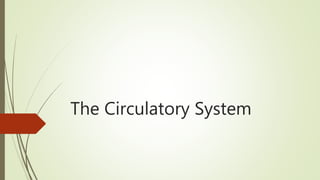
The-Circulatory-System-HEART.pptx
- 2. The circulatory system is the life support structure that nourishes your cells with nutrients from the food you eat and oxygen from the air you breathe. It can be compared to a complex arrangement of highways, avenues and lanes connecting all the cells together into a neighborhood. Sequentially, the community of cells sustains the body to stay alive. Another name for the circulatory system is the cardiovascular system. The circulatory system functions with other body systems to deliver different materials in the body. It circulates vital elements such as oxygen and nutrients. At the same time, it also transports wastes away from the body.
- 4. The following are the three major parts of the circulatory system, with their roles: 1. Heart – pumps the blood throughout the body 2. Blood vessel – carries the blood throughout the body Arteries - carry oxygenated blood away from the heart to the cells, tissues and organs of the body Veins - carry deoxygenated blood to the heart Capillaries - the smallest blood vessels in the body, connecting the smallest arteries to the smallest veins - the actual site where gases and nutrients are exchanged 3. Blood – carries the materials throughout the body
- 5. TYPE OF CIRCULATION DESCRIPTION DIAGRAM 1. Pulmonary Circulation Movement of blood from the heart, to the lungs, and back to the heart 2. Coronary Circulation Movement of blood through the tissues of the heart 3. Systemic Circulation Movement of blood from the heart to the rest of the body, excluding the lungs Circulation
- 6. The Human Heart The heart is a hollow muscle, which is just as big as your fist. It has four chambers with specific tasks to do: two ventricles and two atria. The atria are the receiving chambers of the heart, accepting blood from the body (right atrium) and from the lungs (left atrium). The ventricles are the pumping chambers, moving blood to the lungs (right ventricle) and into the body (left ventricle).
- 7. The heart has two pumps. Each pump has two chambers, the upper and lower chambers. The upper chamber is the atrium that receives blood coming in from the veins. The lower chamber is the ventricle that forces the blood out into the arteries. There is a valve between each atrium and ventricle to prevent the blood from flowing backwards. The valves are like one-way doors that keep the blood moving in only one direction. Valves control movement of blood into the heart chambers and out to the aorta and the pulmonary artery
- 8. THE CHAMBERS OF THE HEART
- 9. All of the muscle tissues of the heart do not contract at the same time. Different parts of the heart contract at different times. When the top portion contracts, the bottom part relaxes. When the bottom contracts, the top relaxes. When a chamber contracts, it becomes smaller and the blood inside gets squeezed or pumped out.
- 10. KEY CONCEPTS The heart is a hollow muscular organ, about the size of your fist, which is located in the center of your chest between the lungs. It is a double pump that pumps on the left and right sides. Every side is divided into two chambers, the atrium and the ventricle, each of which has left and right portion, totaling to four chambers altogether. The top chamber is the atrium (plural: atria). The bottom chamber is called the ventricle. The valve acts as a oneway door, allowing blood to flow either forward into the next chamber, or out of the heart.
- 14. The Rhythm of My Heart Objectives: Measure and describe your pulse (heart rate) after several different activities Explain how to use different time intervals to measure your heart rate Materials: Stopwatch / timer Data Logbook Procedure: 1. Sit quietly for a few minutes before beginning the activity. 2. When you are ready, place your first two fingers either on your neck or on the inside of your wrist and locate your pulse. 3. Once you find your pulse, start the watch, and for 60 seconds, count the number of beats you feel. That is your pulse. 4. Try the experiment again, but this time count for only 30 seconds. When you are done, multiply your count by two. Compare your pulses. 5. Repeat by counting for 15 seconds and multiplying your count by four, then counting for 10 seconds and multiplying by six, and so on. 6. Once you have determined your resting pulse, go to a place where you can exercise vigorously for at least one minute. Exercise of this sort might include a fast jog, running stairs, skipping rope, or doing pushups. When you are done, you should be breathing hard. 7. Choose the length of the test you wish to perform and find your pulse again. 8. Compare your resting pulse with your pulse after exercise. 9. After the activity, record your observations and answer the guide questions.
- 15. Guide Questions: Q20. What was your calculated resting pulse? ______________________________________________________________________ Q21. What was your pulse after exercising? ______________________________________________________________________ Q22. How would you differentiate your heart rates before and after exercising? ______________________________________________________________________ Q23. What is the advantage of timing for a full minute to find your pulse? ______________________________________________________________________ Q24. What is the advantage of timing over a shorter period of time, especially when you have just finished exercising? ______________________________________________________________________ Q25. According to statistics, the maximum heart rate should be 220 minus a person's age. How would you interpret your highest heart rate in relation to that given number? _____________________________________________________________________